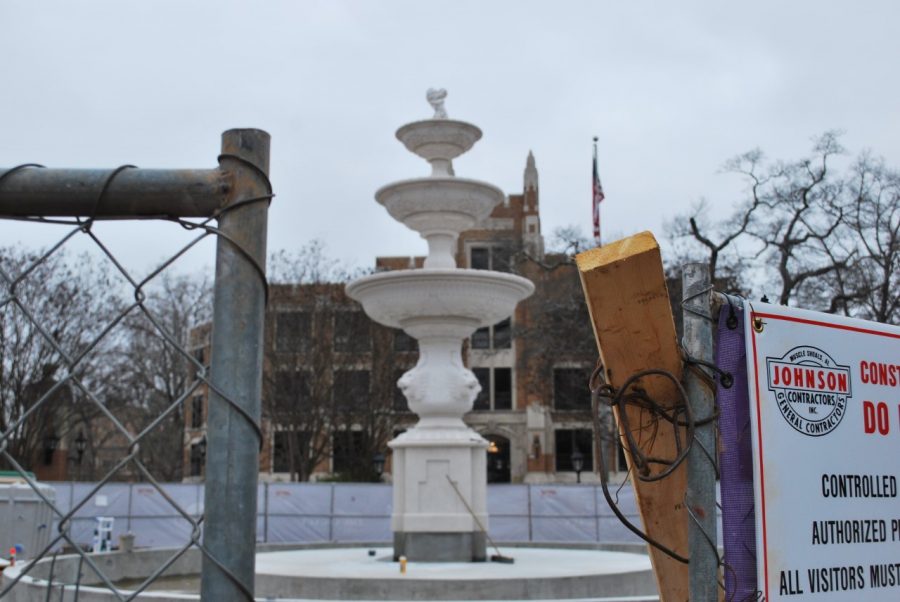Harrison Fountain: What makes an icon
January 29, 2021
On Dec. 18, 2019 the beloved Harrison fountain, located in the heart of the University of North Alabama’s campus, collapsed after having stood for 17 years.
After the collapse, those within the UNA community and the surrounding Florence community mourned the loss of the fountain.
“Just like everyone else, I was greatly saddened,” said Vice President for Advancement, Kevin Haslam. “It’s such an iconic piece of this campus and it means so much to so many people…”
In the days that followed, the question of what caused the fountain to collapse rose.
“Due to the porous nature of Italian Limestone and the freeze/thaw conditions that are experienced in North Alabama, the Italian limestone degraded faster than harder materials such as marble,” said the Assistant Vice President, Facilities Administration and Planning, Michael Gautney. “This led to spalling of the material and, ultimately, the failure of the lower bowl of the fountain.”
The collapse of the fountain was more than just the loss of a quintessential part of campus, it was the loss of one of the many things that makes UNA so special.
“It’s [Harrison fountain] placement at the historic southern entrance to campus, proximity to the administration building and what, in many ways, has been the academic core of the campus makes this really important…” said the President of the UNA, Kenneth D. Kitts.
Since the decision to turn the central road of UNA into a walk way, Harrison Plaza and the Harrison fountain has become a place where students commune.
“It made it one of the more enchanting and beautiful college entrances anywhere,” said Kitts. “… so, I think that for students and alums and the folks that work here that Harrison Plaza has a special place in the way we think about the university.”
When the fountain collapsed, the heartbreak within the UNA community was overwhelming.
It was after students had gone home for winter break and the fall commencement had taken place; but that did not stop students from coming to mourn the loss of a staple on UNA’s campus.
“… that night, and even the following night or two, we [the Kitts family] watched as these little clusters of students… milling around the plaza, looking at the fountain and just kind of sitting there,” said Kitts. “I went out and talked to some of them and they were crying.”
It was clear to Kitts that the collapse of the fountain had affected UNA’s students greatly. Kitts understood that the fountain was more than just a fountain, it was an icon.
For Kitts, there was no question regarding if the fountain should be replaced, but how would it be replaced.
“The marble material is much less impervious and should extend the life of the new fountain well beyond what was experienced with the Italian Limestone,” said Gautney.
Gautney added that after many Requests for Proposals (RFP), the University selected Garden Ornaments Stone to create and carve the new fountain. The new fountain model was based on the design of the original fountain.
“Each of the elements of the fountain were carved, crated, and shipped to UNA by ship from Italy,” said Gautney. “Shipping of the fountain from Italy to Florence, Alabama, was expected to be approximately 6 weeks. Due to issues at various ports, the shipment was received in just over 8 weeks.”
In addition to the new fountain, Harrison Plaza is getting some cosmetic upgrades as well.
“The Board of Trustees had approved the restoration of the fountain and the plaza at about the cost of a million dollars, with the understanding that all the monies would come from insurance and private donations” said Haslam.
Haslam and his team then began to think about how to raise funds for not just the fountain, but the surrounding area. They wanted to engage and include as many individuals as possible to honor the true significance of Harrison Plaza.
“Over the course of six to eight weeks, we developed The Legacy Initiative with the goal in mind of meeting our mandate for the Board of Trustees,” said Haslam.
The Legacy Initiative was a way for the University to give everyone the opportunity to ensure their legacy at UNA, while also helping to rebuild the plaza.
The initiative had two phases. The first being the restoration of Harrison Plaza that will continue until the project is fully funded. The second being securing funds and establishing an endowment for the greatest needs and emerging priorities of the University.
Haslam explained that his hope for The Legacy Initiative is to guarantee anyone who wants to have their name forever etched in Harrison Plaza can. The second was that the fountain and the plaza would be restored not just to their original beauty but to something even greater.
Those interested could purchase a piece of the original fountain, a bench with a name plaque on it, a tree with a name plaque underneath it, a 3’ x 3’ marble square, a 2’ by 2’ plaque or an engraved brick. All but the benches and trees are still available online.
“They [the graduates] received a piece of the fountain as a part of their graduation packets from the University,” said the Director of Communications and Marketing, Michelle Eubanks. “That was a significant thing, as it [the fountain] fell as a part of their tenure as a senior.”
The restoration of Harrison Plaza and the fountain are expected to be complete by March 11, for the Light the Fountain ceremony.
Light the Fountain is a UNA tradition that began in the spring of 2016 by Kitts himself. After arriving in Florence, he was in the President’s home one night and all the sudden, the lights of the fountain shone through his window.
It was then that Kitts knew that this needed to be a celebrated event and a tradition of our wonderful institution. It has since become so much more.
“There’s still a lot to be worked out because we don’t know where we’re going to be with the pandemic,” said Kitts. “We have committed that there will be a Light the Fountain, and it will doubtlessly look different from the pre-pandemic versions…”
Kitts added that there needs to be a commemoration of the completion of the new plaza and fountain and Light the Fountain will be just that.
“I really believe that the return of the fountain really becomes almost a metaphor for the return of normalcy to UNA,” said Kitts. “It was no accident that the fountain collapses in December and then you’re in a pandemic two months later. The weirdness of 2020 began here about a month early.”
Kitts added that the lighting of the new fountain will serve as a morale booster for students who have had to endure the Coronavirus pandemic after losing both their fountain and their beloved mascot, Una.
This year, Light the Fountain will feature music, t-shirt giveaways, a pep rally and the ceremony will begin at 7:30 pm.
“It’s a little bit different, we aren’t going to have food,” said Assistant Vice President for Student Affairs, Tammy Jacques. “We are going to require the face coverings there and we’re going to encourage people to social distance…”
While Light the Fountain might look a bit differently this year, the love that the UNA community bears for the fountain will be stronger than ever.
After all that UNA has been through in the last year, everyone is craving a sense of comradery.
“It is important for this campus community,” said Kitts. “It didn’t take me too long to understand that our folks here really identify with the fountain and when we talk about what makes us [UNA] stand apart… we’ve got lions, and that’s kind of different, and we’ve got Kilby… but I would also say that we’ve got the fountain and we’ve got the plaza.”



